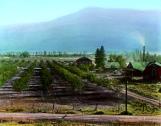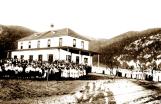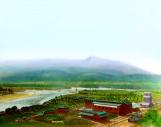6
Lands were purchased in the Grand Forks area as well and as elsewhere, the Grand Forks villages would too develop self-sufficient enterprises. Here, the Doukhobors not only developed sawmills but they built a brick factory, and soon many of the Doukhobor buildings were built with brick as opposed to wood only.Because of the climate and rather flat prairie-like features of the Grand Forks area, wheat was farmed and harvested, and a small flour mill was subsequently built. Fruit trees, strawberries, blackberries, blueberries, and raspberries were planted here too, and used in preservatives which the Doukhobors were not only fond of, but had mastered the art. A small preservative works was built in Grand Forks as well.
8
Carpentry was a common craft learned by men from every village and tailors who made clothing for the community were as prevalent as the women who still maintained their talent of weaving. Additional land was purchased in Alberta in the Lundbreck and Cowley area; farming and raising livestock were a feature to augment the other operations. By 1911, the Doukhobors had pushed back and cleared forests, planted over fifty thousand fruit trees, built roads, ferries, and drawbridges. It appeared that Verigin's dream of a self-sufficient, self-reliant, peaceful, utopian community was coming true and there was very little that the Doukhobors required from outside the community.10
In all, some ninety villages were eventually built in the area of Boundary-Kootenay region, but in an even more communal manner than what happened in Saskatchewan. Instead of side by side one-family dwellings on a wide street facing each other, the villages in BC were modeled after each other, each having two main Doms (homes) each which had a kitchen, eating area, main meeting room, and bedrooms.Each village had outbuildings - the traditional banya (sauna or bathhouse), blacksmith, barn(s) and always, a U-shaped multi-purpose building. In these villages, families would supposedly live together in peace and harmony and it was not uncommon for each village to have 50 to 60 residents, 8 to 10 families, each working for the common purpose. Unlike the villages in Saskatchewan, the majority of villages were identified by the elder who prevailed (for example, Ziberov Village would be named accordingly after the head elder, Nicholai Ziberov) though a few villages kept traditional Russian names (translated: 'Gift of God' or 'Peace' for example).
11
Doukhobors sort fruitCirca 1925
West Kootenays, BC, Canada
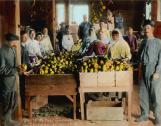 Credits:
Credits:Photo by Thomas Gushel, a famed photographer of Doukhobor culture
12
Life in the village began at the break of dawn; the women arising and starting a large and hearty vegetarian breakfast. Breakfast began with prayers and group singing, and once breakfast was finished, there would be more psalms, hymns and prayers before starting the day. In the early years, the day meant pulling stumpage, cutting timber and clearing the Doukhobor lands but later, those tasks were replaced with falling timber for profit or maintaining the orchards and grain fields they kept.From milling timber to milling flour, to planting and harvesting their fields of orchards of grain, the Doukhobors' life was certainly not one of leisure and their motto "Toil and Peaceful Life" was as alive in practice during this time, as in any time of their history.
13
Oche Nash (The Lord's Prayer) sung in Russian1967
Grand Forks, BC, Canada
 Credits:
Credits:Centenial Doukhobor Choir
14
Along with the prerequisite prayers, hymns and psalms, lunch would be a communal experience as well (unless the workers were hired out to enterprises outside the community's needs). At the end of the work day, a communal dinner was served and as with breakfast, prayers, hymns and psalms preceded the meal and continued after. Bedtime was early, for a new day would begin soon enough. The work day was usually an 11 hour ordeal but no one really kept a 'time sheet'.15
Sobranie (Peter V. Verigin cethered in grey suit)Circa 1920s
Brilliant, BC, Canada
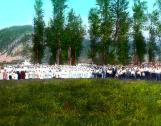 Credits:
Credits:From the Autochrome Exhibit, Doukhobor Village Museum, Castlegar, BC
